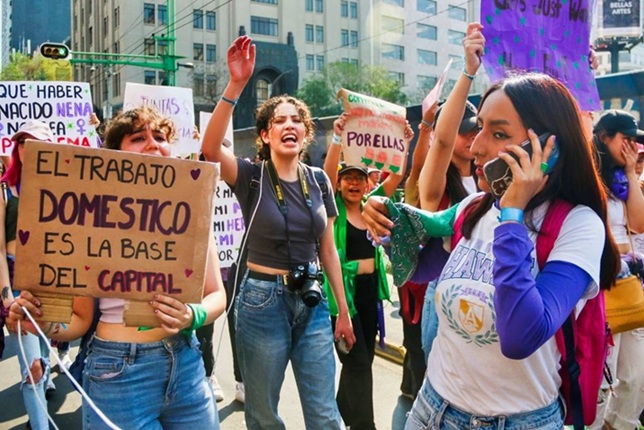With the assault on President Sheinbaum earlier this month while she was walking in public around CDMX, there’s been renewed attention on the immense problem of violence against women in Mexico.
My first thought after hearing about this incident was … how does Sheinbaum’s security detail allow some drunk rando to approach their head of state from behind and grope her on a public street? Especially given the epic levels of political violence across Mexico this year?!
Next, I wondered if she’d be handing out pink slips to that entire security team—even before pressing charges for the assault. After all, there needs to be accountability when people and processes fail.
After the dust had settled a little, I started to dig into the risks Mexican women face and how violence against women in Mexico differs by location. I mean, if even the President of the Republic can be assaulted, what hope is there for everyone else?
Violence Against Women in Mexico by the Numbers
According to government figures published by INEGI (the National Institute of Statistics and Geography), roughly 70%+ of Mexican women report experiencing some form of violence in their lives, including aggression by a romantic partner. The data also show that nearly 50% report being victims of sexual violence at some point in their lives, and approximately 52% of Mexican women have experienced psychological abuse.
And while 9 in 10 murder victims in Mexico are men, the huge escalation in violent crime in Mexico generally over the past 10 years has coincided with big increases in femicides specifically. (+145% in the past decade)
An average of 10 women and girls murdered are murdered every day across Mexico, with 3 in 10 typically classified as femicides.
The Mexican government only began classifying femicides as a specific crime in 2012, so long-term trend analysis isn’t feasible. (Femicide is female homicide that is gender motivated.)
With only 5% of crimes against women getting solved, it’s a real crisis. Impunity emboldens more to engage in these crimes.
And while the media focuses on cartel-related violence in Mexico, about one-third of femicide victims here are killed by their current or ex-partners.
These patterns stem from a deeply entrenched machismo culture in Mexico, where aggression towards women was normalized and public institutions routinely dismissed and/or downplayed violent crime against women, devoting few resources to stopping it.

One of the more shocking crimes I’ve heard about while living in Zapopan (a city in the Guadalajara Metro Area) was the murder of Valeria Márquez. A former beauty queen and content creator, Márquez was gunned down in her salon last May while live-streaming on TikTok.
The assassin, posing as a deliveryman, calmly confirmed her identity before blowing her away. Though Márquez had shared messages suggesting she feared her ex-partner, no one has yet been charged. Mind you, this crime occurred in a posh neighborhood where people play tennis and houses can fetch a million USD.
What’s driving these huge increases, you ask?
There are no definitive answers, but it coincides with a rise in violent crime generally across Mexico. It’s also clear that with any disenfranchised group gaining rights and making economic progress, there will be a backlash from those who dislike the changes.
Which Mexican States Have the Worst Rates of Gender Violence?
These problems are enduring and widespread, but that’s not to say they’re equally common across Mexico.
The highest rates of femicide are concentrated in a handful of smaller and less populous states. But tracking these crimes at the state level is tricky because the federal government doesn’t compile femicides by state, and state-level practices are wildly inconsistent.
Nonetheless, it’s possible to rank states by incidence if you look at multi-year trends and consult multiple sources.
Based on government data and press reports, the states with the highest femicide rates are Colima, Morelos, Nuevo León, and Baja California, with border zones being especially notorious. In absolute terms, the greatest volume of cases occurs in the most populous states of Estado de México, Jalisco, and CDMX.
Where Femicide Rates in Mexico are Highest: 2022-2024

I’d also like to give a special shoutout to Ciudad Juárez (Chihuahua), where extreme levels of femicide and gender violence have made it one of the deadliest places for women in Mexico. From 1993 (incidentally, the start of NAFTA) through 2023, an estimated 2,500 young women and girls were murdered, with hundreds more missing.
This border town, both a drug-trafficking hotspot and manufacturing center for the automotive and electronics industries, has historically posed a particularly high risk for the women who live and work there.
At the other end of the spectrum, the Yucatán, Tlaxcala, and Quintana Roo see far lower rates of violence against women.
Why National Data Understate the Risk to Women
The numbers shared above are a useful starting point for understanding the risks and recent trends. But it’s important to note that official counts seriously understate the incidence of violence against women in Mexico.
Five factors contribute to official crime statistics undercounting the scale of the problem.
- Underreporting. Most women do not report incidents to authorities or file official complaints. The reasons include shame, fear of retaliation, the likelihood of victim blaming, and lack of trust in the police to hold criminals accountable. An attitude of … Why bother? Nothing will be done anyway … tends to prevail.
- Misclassification (femicide vs homicide). Not every murder of a woman is investigated/recorded as femicide. Some deaths are logged as general homicide or “unknown circumstances,” so gender motivation gets lost in counts.
- Missing persons & unidentified bodies. Large numbers of disappeared people and unidentified corpses make linking deaths to gender-based motives a challenge. Some murdered women are never identified, so they won’t enter femicide statistics, according to journalists and NGOs.
- Geographic and social barriers. Indigenous and rural women often have less access to legal recourse, legal aid, shelters, and forensic services — so violent crimes in these areas are rarely captured in national stats.
- Data lags, politics, and intentional minimization. Different time windows, delayed reporting, and political incentives to show improving trends can make year-to-year comparisons dubious, according to NGOs.
How Much Legal Protection Do Women in Mexico Have?
In 2007, Mexico established a national system to address and punish violence against women and has amended it more recently to cover new types of violence (cyber-bullying) and increase penalties. But funding cuts under AMLO for violence prevention programs and response services leave Mexican women more vulnerable.
Legal gaps also remain. As of 2025, only 16 of Mexico’s 32 states criminalize sexual harassment. And, incredibly, a loophole in the law allows for lesser punishment for the rape of girls than of women. Much work remains to be done to protect women.
Frustrated by the lack of progress, Mexican women have taken to the streets. Each year on March 8th (International Women’s Day), Mexicans come out to protest the rising levels of gender-based violence and the lack of accountability for perpetrators. These events routinely draw tens of thousands.

Is easy to be gloomy about this state of affairs. And yet, there are signs that the culture is changing.
In 2024, full gender parity was achieved in Mexico’s Congress. And there’s no denying the huge milestone of Mexicans electing Claudia Sheinbaum as their first female leader in an election landslide last year.
It’s also a good sign that Sheinbaum decided to press charges against her aggressor (who’s in detention). While it’s not on the same level as solving femicide, it’s an important step.
How to Lower Your Risk as a Woman Living in or Visiting Mexico
With risks on the ground higher than headline numbers indicate, staying safe means using common sense and taking precautions at all times. Women in Mexico should employ various strategies:
- Know your surroundings and avoid neighborhoods with a reputation for high crime.
- Don’t walk alone at night in deserted or dark areas.
- Download a map to your phone of any area you’re in that you don’t know well, and study it before venturing out.
- Take Ubers instead of taxis. Tell friends or family when you plan to take an Uber alone. Let them know when you arrive at your destination safely.
- Never hitchhike anywhere in Mexico or visit beaches at night.
- Don’t tell strangers that you’re out alone (even if you are).
- Fend off unwanted attention or aggressive behavior with direct language and a confident tone.
- Take a self-defense class and kick some ass, if need be.
Sources: SESNP, INEGI, Vision of Humanity, Wikipedia, BBC News.

